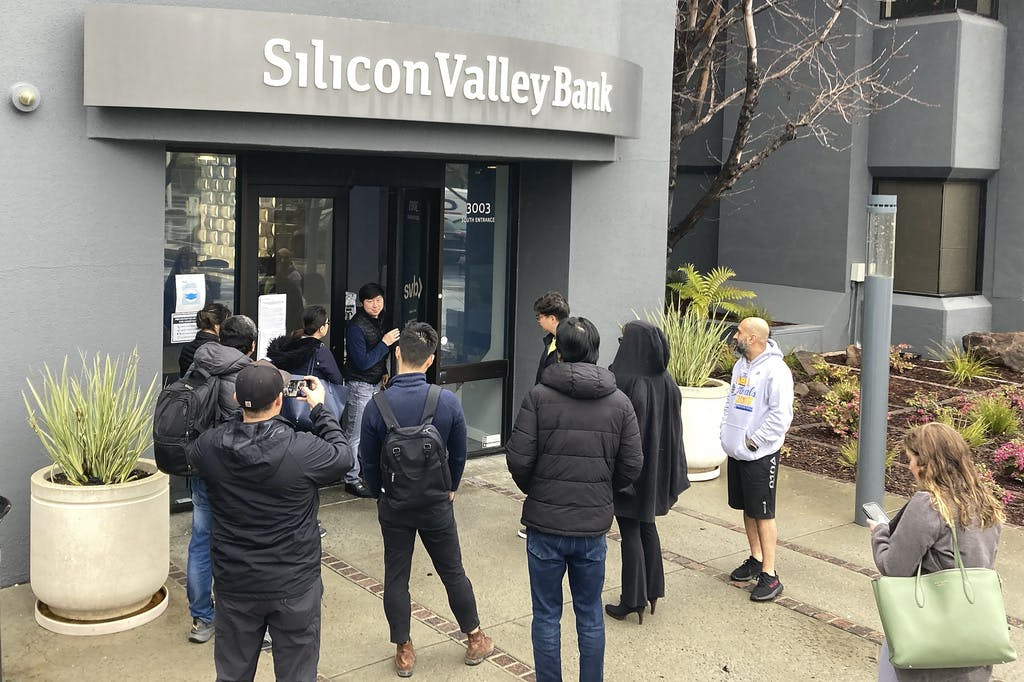Silicon Valley Bank Seized by Regulators After Historic Failure
The nation’s 16th-largest bank failed after its depositors hurried to withdraw money this week amid anxiety over the bank’s health. It is the second biggest bank failure in American history.

Federal regulators rushed to seize the assets of Silicon Valley Bank on Friday after a run on the bank, marking the largest failure of a financial institution since Washington Mutual collapsed at the height of the financial crisis more than a decade ago.
Silicon Valley Bank, the nation’s 16th largest bank, failed after its depositors — mostly technology workers and venture capital-backed companies — hurried to withdraw money this week as anxiety over the bank’s health spread. It is the second biggest bank failure in American history.
The bank had deep ties to Silicon Valley industries and startups. Y Combinator, an incubator startup that has launched companies such as Airbnb, DoorDash and Dropbox, has referred hundreds of entrepreneurs to the bank.
“This is an extinction-level event for startups,” Y Combinator’s chief executive, Garry Tan, said. “I literally have been hearing from hundreds of our founders asking for help on how they can get through this. They are asking, ‘Do I have to furlough my workers?’”
Mr. Tan estimated nearly one-third of Y Combinator’s startups won’t be able to make payroll at some point in the next month if they can’t access their money. He said he is asking regulators and lawmakers if the startups can be eligible for financial aid.
Silicon Valley was heavily exposed to the tech industry but there is little chance of chaos spreading in the broader banking sector like in the months leading up to the Great Recession more than a decade ago. The biggest banks — those most likely to cause a widespread economic meltdown — have healthy balance sheets and plenty of capital.
In 2007, the biggest financial crisis since the Great Depression rippled across the globe after mortgage-backed securities tied to ill-advised housing loans collapsed in value. The panic on Wall Street led to the demise of Lehman Brothers, a firm founded in 1847. Because major banks had extensive exposure to one another, it led to cascading breakdown in the global financial system, putting millions out of work.
There has been unease in the banking sector all week and the news of Silicon Valley Bank’s distress pushed shares of almost all financial institutions lower Friday, shares that had already tumbled by double digits since Monday.
Silicon Valley Bank’s failure arrived with incredible speed, with some industry analysts on Friday suggesting it was a good company and still likely a wise investment. Silicon Valley Bank executives were trying to raise capital early Friday and find additional investors. However, trading in the bank’s shares was halted before stock market’s opening bell due to extreme volatility.
Shortly before noon eastern, the Federal Deposit Insurance Corporation moved to shutter the bank. Notably, the FDIC did not wait until the close of business to seize the bank, as is typical in an orderly wind down of a financial institution. The FDIC could not immediately find a buyer for the bank’s assets, signaling how fast depositors had cashed out.
The White House said that Treasury Secretary Yellen is “watching closely.” The White House sought to reassure people that the banking system is much healthier than it was in the Great Recession.
“Our banking system is in a fundamentally different place than it was, you know, a decade ago,” said the chairwoman of the White House Council of Economic Advisers, Cecilia Rouse. “The reforms that were put in place back then really provide the kind of resilience that we’d like to see.”
Silicon Valley Bank had $209 billion in total assets at the time of failure, the FDIC said. It was unclear how much of its deposits were above the $250,000 insurance limit, but previous regulatory reports showed that much of Silicon Valley Bank’s deposits exceeded that limit. The FDIC that deposits below the $250,000 limit would be available Monday morning.
The bank still appeared stable this year, but on Thursday it announced plans to raise up to $1.75 billion in order to strengthen its capital position. That sent investors scurrying and shares plunged 60 percent. They rocketed lower again Friday before the open of the Nasdaq, where it is traded.
As its name implied, Silicon Valley Bank was a major financial conduit between the technology sector, its founders and startups as well as its workers. It was seen as good business sense to develop a relationship with the bank if a founder wanted to find new investors or go public.
Conceived in 1983 by co-founders Bill Biggerstaff and Robert Medearis during a poker game, the bank has leveraged its Silicon Valley roots to become a financial cornerstone in the tech industry.
Silicon Valley Bank’s ties to the tech sector have added to its troubles. Technology stocks have been hit hard in the past 18 months after a growth surge during the pandemic and layoffs have spread throughout the industry. Venture capital funding has also been declining.
At the same time, the bank was hit hard by the Federal Reserve’s fight against inflation and an aggressive series of interest rate hikes to cool the economy.
As the Fed raises its benchmark interest rate, the value of bonds, typically a stable asset, start to fall. That is not typically a problem but when depositors grow anxious and begin withdrawing their money, banks sometimes have to sell those bonds before they mature to cover that exodus.
That is exactly what happened to Silicon Valley Bank, which had to sell $21 billion in highly liquid assets to cover the exodus of deposits. It took a $1.8 billion loss on that sale.
Associated Press
